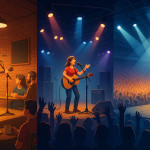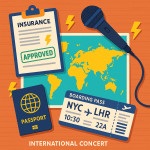Plan a 2025 showcase tour: mapping singer events that boost visibility
Ready to turn 2025 into the year you stop chasing gigs and start attracting them? This guide walks you step-by-step through building a strategic showcase tour. You will learn how to choose high-impact singer events, cluster dates geographically, pitch to bookers, and track the visibility gains that translate into paid work.
Why a showcase tour still matters in 2025
Live-stream fatigue is real. Talent buyers crave in-person proof that an artist can own the stage and move an audience. A well-planned showcase tour lets you:
- Compress discovery, networking, and press coverage into a 6–12-week sprint.
- Create social-media moments that algorithms prioritise over studio content.
- Leverage economies of scale—one press kit, one travel kit, many opportunities.
Step 1 – Clarify goals before you book a single date
Visibility KPIs that actually move careers
Choose metrics you can measure within 30 days of each performance:
- Number of booking enquiries added to your CRM
- Press mentions beyond event listings (quotes, reviews, photos)
- Follower growth in target territories (geo-tagging is key)
- Playlist adds or sync pitches triggered by the show
Knowing your KPIs prevents “busy-tour syndrome,” where you rack up shows but no traction.
Step 2 – Map the 2025 singer event calendar

Imagine laying a transparent world map over your booking spreadsheet and watching invisible pathways light up wherever high-impact events overlap with your target cities. That is the essence of strategic routing. Begin by plotting the festivals and conferences that already attract the tastemakers you need—A&R reps, sync agents, and boutique bookers who shape next year's line-ups. Next, layer in regional showcases that align with your genre and brand story, prioritising those with early-bird application discounts. Finally, cross-reference everything with affordable transport corridors and visa requirements. When your calendar looks more like a cleverly solved jigsaw than a random scatter of pins, you know every kilometre travelled will earn you maximum face-time, press potential, and carbon efficiency.
Start with industry fixtures—then add regional gems that fit your brand. The table below highlights prime visibility windows.
| Month | High-Impact Event Type | Average Scouts Attending* | Pitch Deadline |
|---|---|---|---|
| January | Talent-buyer summits | 120 | Oct 15 2024 |
| March | Global showcase festivals | 350 | Nov 30 2024 |
| June | Music trade fairs | 200 | Feb 01 2025 |
| September | Cultural city weeks | 180 | May 20 2025 |
| November | Sync & branding expos | 90 | Jul 15 2025 |
*Compiled from 2023 attendance reports by Pollstar and regional tourism boards.
Step 3 – Prioritise event types that amplify your brand
1. Showcase festivals
These multi-venue events curate short sets and attract a high scout-to-artist ratio. They are ideal for emerging acts who need volume exposure. Pair them with advice on choosing singer events aligned with your goals.
2. Trade fairs & conferences
Five-minute elevator pitches can turn into foreign tour legs. Prepare a stripped-down acoustic set for booth demos and leverage strategic networking tactics to maximise ROI.
3. Themed city weeks
Think “Jazz Week,” “Latin Week,” or “Indie Winter.” These attract niche press hunting for fresh stories. A genre-matching line-up positions you as part of a bigger narrative.
4. Eco-conscious festivals
Sustainability badges matter to brands. Brush up on green touring practices to win slots with sponsors that share your values.
Step 4 – Sequence dates to slash travel costs and carbon
Cluster cities within 300 km of each other before crossing oceans. Use rail routes where practical. Besides shrinking your footprint, you free up budget for local PR pushes or an extra videographer.
Toolbox: the three-ring map method
- Plot top-tier events on a map.
- Add second-tier venues within a 2-hour radius.
- Fill gaps with radio sessions or fan meetups.
Visual clustering also reveals off-nights you can monetise with house concerts or songwriting workshops.
Step 5 – Build a realistic showcase tour budget
- Registration fees : €50–€350 per event
- Travel & freight (guitars, merch stand) : 20–40 % of total spend
- Accommodation : aim for partner hotels at event rates
- Promo assets : new video teaser + updated EPK
- Fallback fund : 10 % cushion for emergency rerouting
Secure sponsorship early—equipment brands often underwrite travel if content deliverables are clear.
Step 6 – Pitch like a pro and meet every deadline
Programmers hate PDFs over 5 MB and subject lines without genres. Follow these rules:
- Lead with a one-sentence unique selling point.
- Embed, don't attach, a 60-second reel (link to a polished directory profile).
- Reference at least one past show with similar audience size.
- Offer flexible set lengths—gives curators scheduling wiggle room.
For recurring festivals, mention last year's ticket-sales stats to prove you've done your homework.
Step 7 – Promote every date before, during, and after
Pre-tour buzz
- Announce the full route on curated singer event listings sites fans already browse.
- Launch a two-week playlist takeover featuring artists on the same bill.
Real-time engagement
Use geo-targeted ads one day before each showcase. Attendance jumps when locals see “Tomorrow night—free industry wristbands left!”
Post-show ripple
Clip best-of moments into 15-second Reels while the crowd is still tagging you. Tag the festival's press account to extend reach.
Step 8 – Measure visibility gains and iterate
Within 48 hours of each event, log these numbers:
- New playlist adds
- Media requests received
- Email open rate for city-specific follow-up blast
- Increase in local followers
Benchmark against your KPIs. Drop under-performing cities on the next leg, double down where growth spikes.
Quick self-test: are you showcase-tour ready?
FAQ
- How many events should my first showcase tour include?
- Six to eight dates let you test multiple markets without overwhelming your promo bandwidth or budget.
- Is it worth paying for a prime showcase slot?
- If the event guarantees scout attendance and press coverage, a paid evening slot can yield a stronger ROI than a free lunchtime set.
- Can virtual showcases replace live ones in 2025?
- They complement but do not replace them. Programmers still rely on live energy and networking that can't be replicated on screen.
- What's the biggest budgeting mistake artists make?
- Underestimating last-minute logistics—rush shipping for merch, visa fees, or backline rentals. Keep that 10 % emergency fund intact.
- How soon should I update my EPK after a showcase?
- Within one week. Add press quotes, professional photos, and crowd metrics while interest is high.
Take the next step
You now have a roadmap to design a showcase tour that turns stages into stepping-stones. Draft your calendar, lock application deadlines, and refine your pitch deck today. The sooner you commit, the higher your chances of claiming the most coveted 2025 spots.











